There are infinite ways to get your bat to the baseball. For the hundreds of Major League hitters, there are hundreds of unique swings -- fast swings, slow sings, long swings, short swings, swings from open batting stances, swings from closed batting stances, uppercut swings, flat swings.
Statcast's new bat tracking data has given us more detail about those swings like never before. We can measure bat speed and swing length … batting stance and contact point … and now, for the first time, swing path, attack angle and attack direction.
The new leaderboard just launched on Baseball Savant with three new metrics that help us characterize the different styles of swings that MLB hitters have:
- Swing path -- the vertical tilt of the swing on the way toward contact. This tells you if a hitter has an uppercut swing or a flat swing
- Attack angle -- the vertical direction the barrel of the bat is moving at the moment of contact with the baseball. A swing with a high attack angle at contact is more likely to produce a fly ball, and a swing with a low attack angle at contact is more likely to produce a ground ball
- Attack direction -- the horizontal direction the barrel of the bat is moving at contact. This tells you if the batter is swinging toward the pull field, or the opposite field
These stats let us measure the difference between the steep swing of Aaron Judge and the flat swing of Giancarlo Stanton, the fly ball swing of Cal Raleigh vs. the ground ball swing of Yandy Díaz, the pull swing of Nolan Arenado vs. the oppo swing of Juan Soto.
You can read all about the new stats and what they mean here. But right now, let's take a look at the hitters on both ends of the spectrum this season.
Here are the most extreme swings in the Major Leagues in 2025. (All stats below are entering this week, for hitters with at least 100 competitive swings.)
Steepest swing path: Riley Greene -- 46 degrees
Next up: Freddie Freeman -- 42 degrees
The biggest uppercut swing in the Majors belongs to Greene, the only hitter whose bat path is angled more than halfway between a perfectly flat swing (zero degrees) and a true golf swing (90 degrees).
Maybe it's only fitting, then, that Greene is an avid golfer who started applying the golfer's mentality to his "swing thoughts" a couple of years ago before he broke out with the Tigers.
"Like in golf -- a lot of golfers have that one thought before they hop up to the ball," Greene explained at the time. "Just trying to get a new feel for things. Same swing, just different thought."
Freeman's place here is interesting, too, because you might not think of him as an "uppercut" style hitter. His calling card is ripping line drives all over the field. But both things can be true. Freeman is an elite line-drive hitter, his bat just takes a steep path to get to the point of contact.
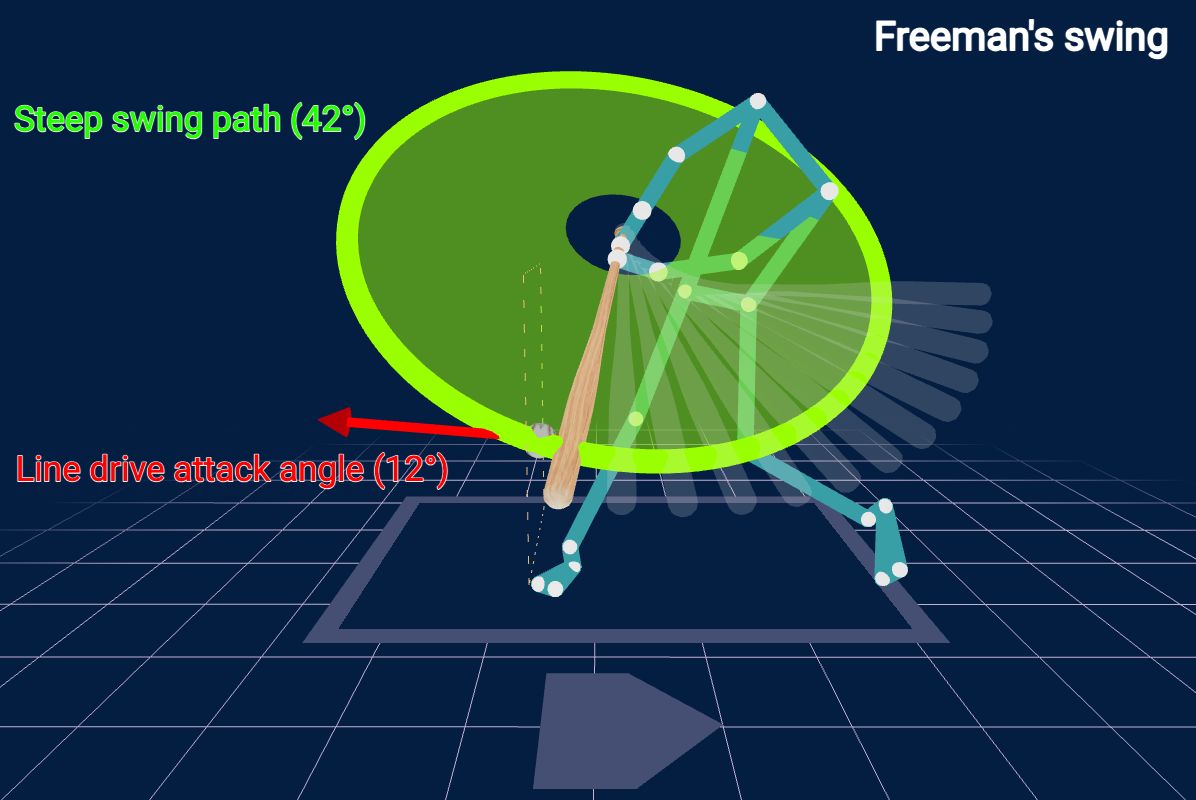
"I slow it down [on tape] and it looks weird," the Dodgers star said of his swing last October. "But, I just … I’ve always just tried to be short to it and inside the baseball. And I played a lot of golf as a kid, and I think that’s why I follow through like I do. But I don’t have a way to explain it. It works and I don't really want to figure it out. Because when you try and figure something out, then it may be gone. You have got to let that thing ride."
There are plenty of other stars with steep swing paths, and they range from power hitters to contact hitters. Aaron Judge (39 degrees) has a steep swing; so does Luis Arraez (37 degrees). Jung Hoo Lee (39 degrees) and Steven Kwan (37 degrees) have steep swings; so do Shohei Ohtani and Mike Trout (36 degrees).
Flattest swing path: Yandy Díaz -- 24 degrees
Next up: Jake Burger, Alejandro Kirk, Anthony Santander -- 24 degrees
Greene, MLB's steepest swinger, has almost twice as much of an uppercut as the flattest swingers, headlined by the Rays' musclebound former batting champion Díaz, whose flat swing drives his all-fields approach.
"I see a massive human swinging a baseball bat," Rays hitting coach Chad Mottola said of Díaz and his swing coming off his 2023 American League batting title. "But just the grace he moves with, the way he’s able to get to pitches in a unique way and just the comfort in his own skin. He has a unique way of staying inside the ball, despite all his mass."
This end of the swing path leaderboard is also where you'll find Stanton when healthy -- last year Big G had a swing plane of 26 degrees, which is an interesting contrast with his fellow Bronx Bomber Judge. Though both sluggers are of similar stature, their swing paths are completely different.
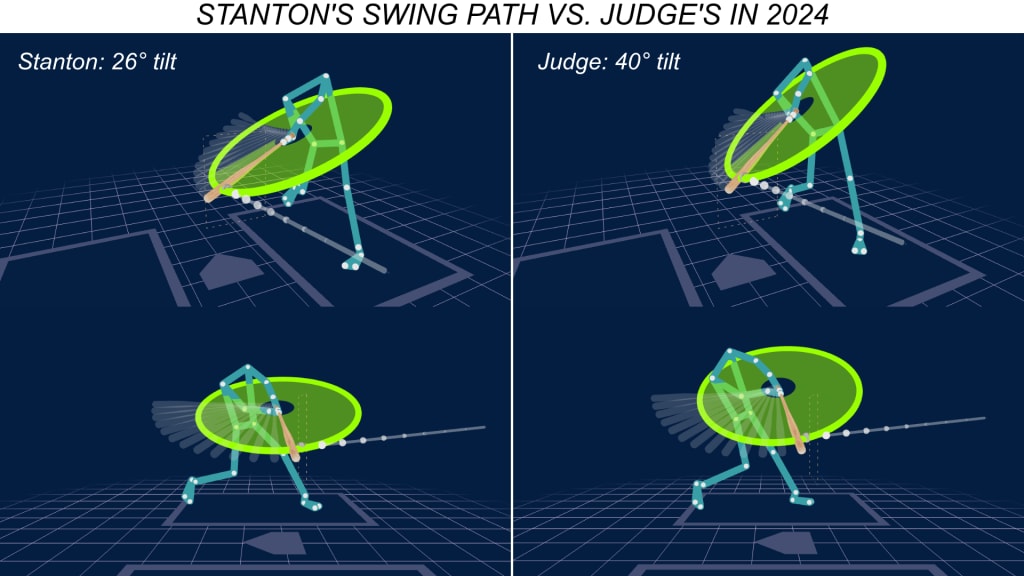
Highest attack angle: Eugenio Suárez -- 20 degrees
Next up: Max Muncy -- 19 degrees
Suárez is one of the biggest fly ball hitters in baseball, and that's because he gets his bat to the ball at the right time during his swing to drive it in the air.
The D-backs slugger has 14 home runs for a reason. His bat meets the ball at a steep upward trajectory, so when he makes square contact, it goes in the air. About 70% of Suárez's contact this season has been air contact, one of the highest rates in the Majors. He's the type of hitter who can have a four-home run game because he's constantly smashing fly balls.
"There's a lot of thump in that bat," then-Mariners manager Scott Servais said of Suárez when Geno was playing for him a few years ago. "There's a reason he's hit as many home runs as he has throughout his career [with] his ability to get the ball in the air and really drive it."
Look at other well-established fly ball hitters like Muncy or Cal Raleigh (18 degree angle in 2025) or Rhys Hoskins (16 degrees), an emerging airball-first slugger like Wyatt Langford (17 degrees), or even an all-around superstar like Shohei Ohtani (16 degrees), and you'll see they also have high attack angles that translate to high launch angles. The way their bat is moving when it hits the ball turns into the way the ball comes off their bat.
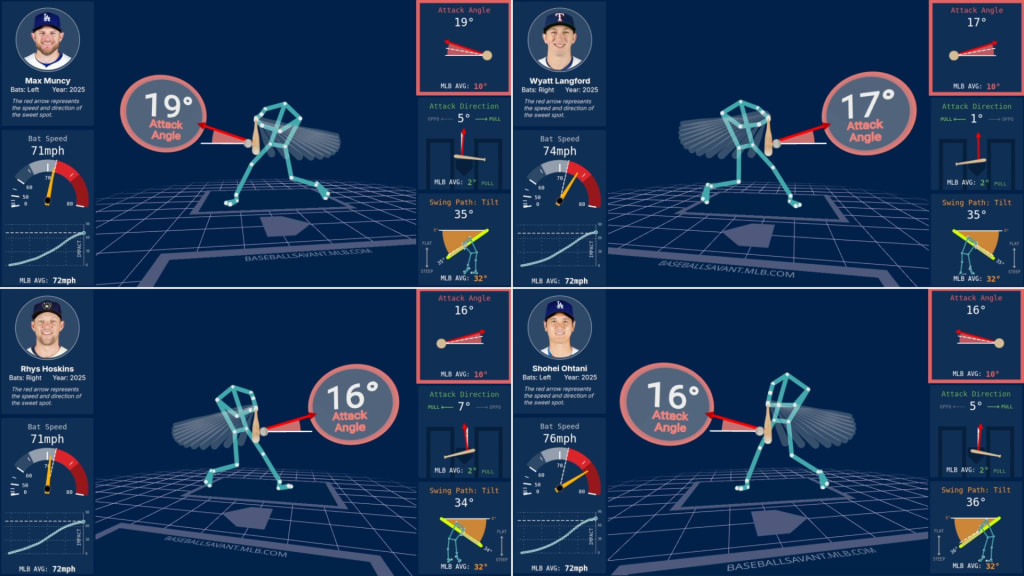
Lowest attack angle: Vladimir Guerrero Jr. -- 1 degree
Next up: Jacob Wilson -- 1 degree
Vlad Jr. hits the ball as hard as anybody, but he's always hit a ton of low missiles, and this is why. His swing is not designed to launch high fly balls, but it is designed to rip baseballs extremely hard, and those frozen ropes are the most important thing.
When Guerrero is going right, enough of those balls get into the air to produce 30-plus or 40-plus homer seasons. But those low attack angles also probably help explain why it's not 40-plus home runs every season, even though Vlad Jr. is always among the league leaders in hard-hit balls and is one of the few hitters who can rip the baseball upwards of 115 mph, even 120 mph. But chasing more airballs might not be worth compromising the swing that's natural for him.
"I just try to hit the ball to the middle, and a line drive," Guerrero said while breaking down his swing on MLB Network after his 48-homer season in 2021. "I don't try to hit a ground ball or a fly ball. I just try to hit it hard, and a line drive ... I think the key for me is hitting line drives. I tried that last year, hitting with launch angle, and all that. And I don't like it."
While Vlad Jr. has the more counterintuitive combination of elite raw power with low attack angles, you wouldn't be surprised to see some of the contact-hitting specialists at this end of the attack angle spectrum like Wilson and Kwan (3 degrees).
Most extreme "pull" attack direction: Isaac Paredes -- 15 degrees
Next up: JJ Bleday -- 14 degrees
Paredes is the poster boy for pull hitters in the big leagues today. He's pulled every single one of his 79 career home runs. He doesn't have great bat speed. He doesn't hit the ball particularly hard. But he is elite at pulling the ball in the air.
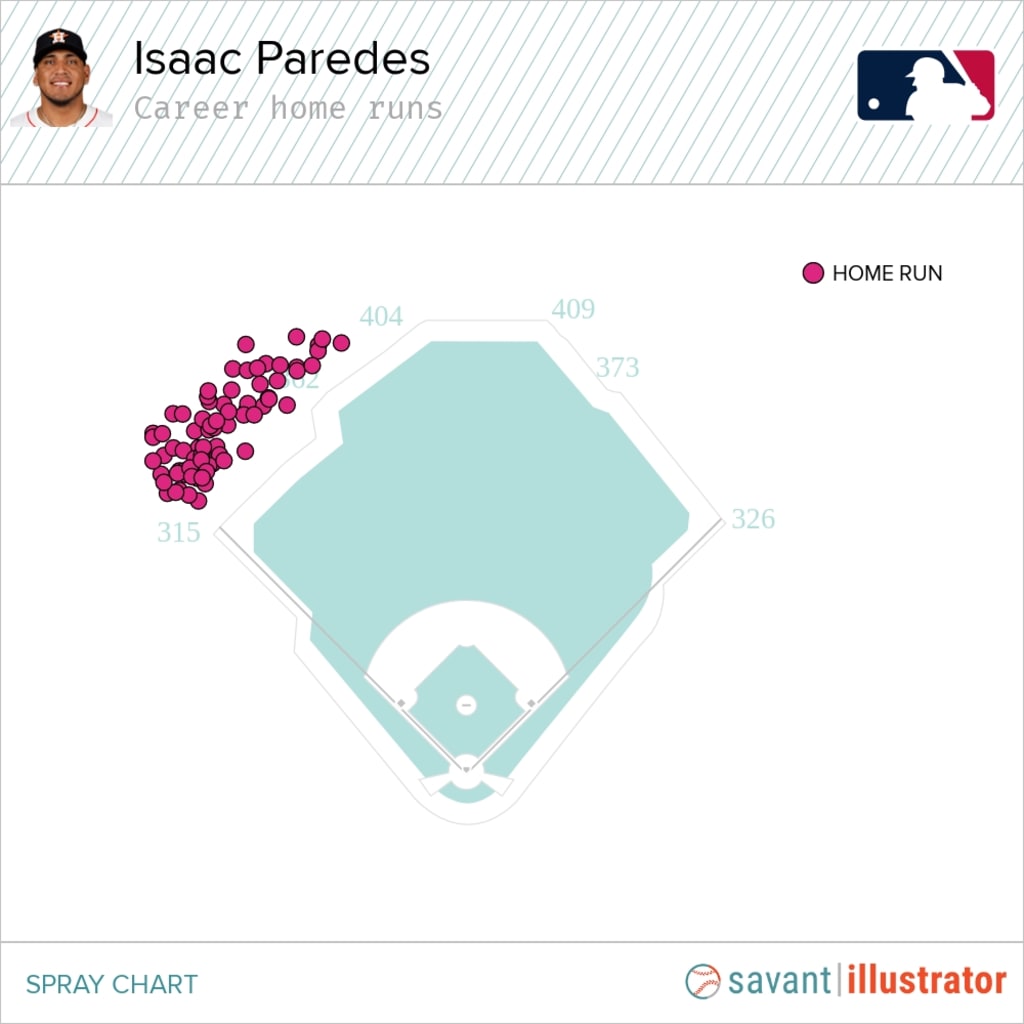
When you break down his swing, it is the attack direction that stands out. Paredes' bat is traveling extremely toward the pull field when he makes contact. Because he consistently lifts the ball to dead left field, he's able to take advantage of the shortest pathway to a home run.
The Rays were the ones who first tapped into Paredes' pull-power potential after they traded for him from the Tigers. Now, that's what makes him an ideal fit for the Astros with the short left-field Crawford Boxes in Houston.
"All the [Rays] coaches were telling me that I don't have pop to center field," Paredes explained back in 2023. "That's why they say to pull the ball."
Or as Mottola, then his hitting coach, put it: "I'd love to say there's a lot more behind the story. The only thing we do is, when he flies out to deep center, we remind him it's a lot closer to left field. I don't know if that's some deep science or thought, but that's really what it is."
Other hitters with similar pull-power approaches also, naturally, have strong pull-side attack directions -- hitters like Arenado (11 degrees pull in 2025), José Ramírez (9 degrees pull), Kyle Tucker (9 degrees pull) and Alex Bregman (6 degrees pull).
Most extreme "oppo" attack direction: Brice Turang -- 11 degrees
Next up: Rafael Devers, Gabriel Moreno, Jackson Holliday -- 8 degrees
Turang is a perfect name to top the list of most extreme opposite-field swings. While the Brewers infielder has made real adjustments this season to increase his bat speed and hit the ball harder, his ability to slap base hits the other way with a short, compact swing is still his signature skill at the plate.
Since the start of last season, no one has hit a higher share of their base hits to the opposite field than Turang (42%), and only Luis Arraez has more total opposite-field hits (85 to Turang's 79).
"I'm not trying to hit homers," Turang said earlier this year. "I've gone down that road, and it didn’t really work out well for me."
Now, you can be an opposite-field power hitter, too, like Devers, who has one of the next-most extreme opposite-field attack directions after Turang. Over the last couple of seasons, Devers has become an extra-base hit machine to the opposite field, especially capitalizing on the Green Monster at Fenway. He adjusted his swing to do so, lowering his hands and using a shorter movement to the baseball.
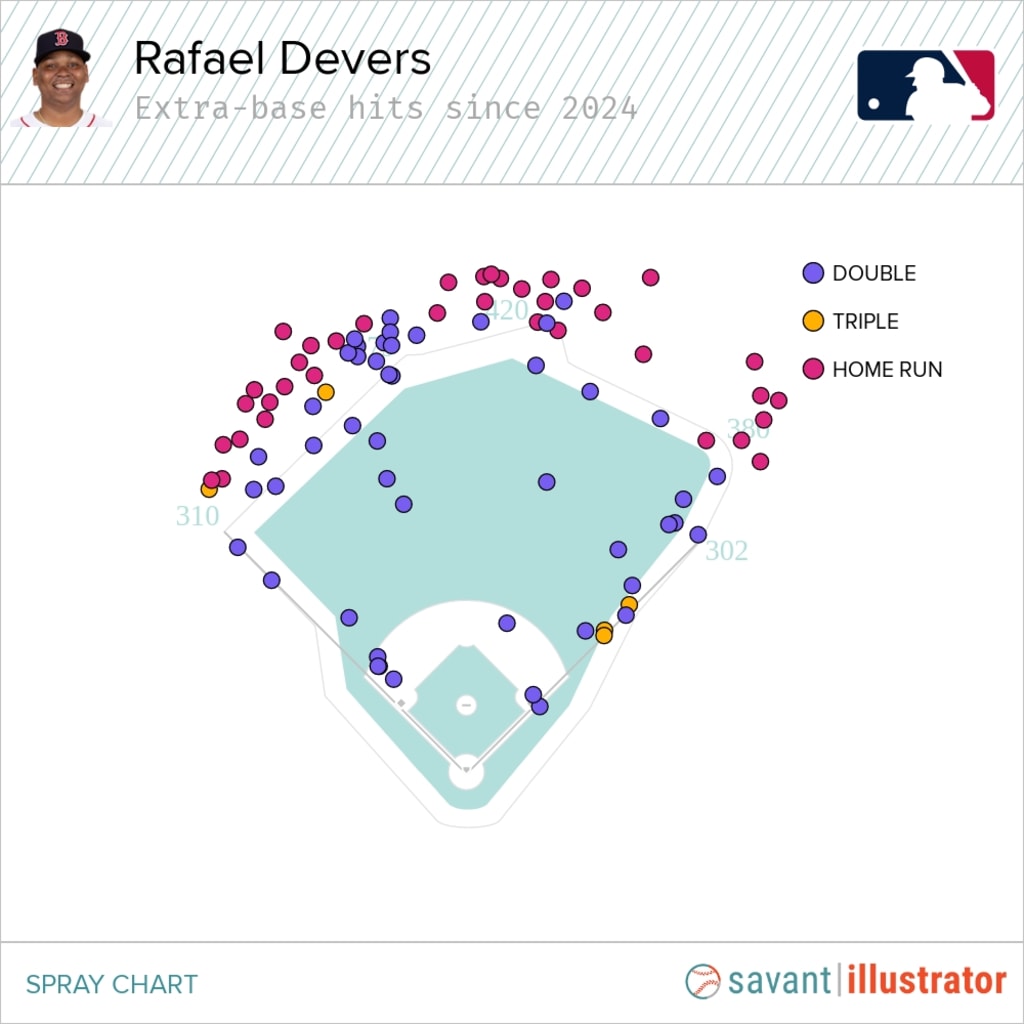
Motivated to combat the high velocity of MLB pitchers today, Devers learned to hit to the whole field with power. He has the most opposite-field home runs of any left-handed hitter since the start of last season (14), one ahead of Juan Soto, and the second-most extra-base hits (33), behind only teammate Jarren Duran. Soto and Duran also swing with opposite-field attack directions (5 degrees and 4 degrees oppo in 2025, respectively).
"[Devers'] advantage, especially at Fenway Park, is that he can mishit balls that go to the fence," Red Sox hitting coach Peter Fatse explained early last season. "He can be late and hit home runs and doubles."
